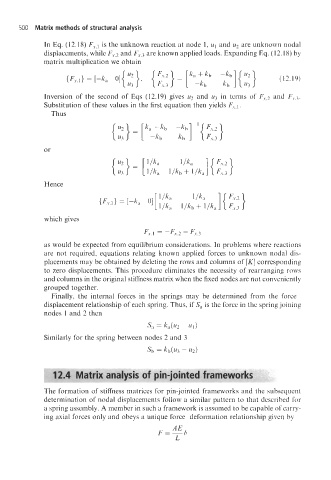Page 519 - Aircraft Stuctures for Engineering Student
P. 519
500 Matrix methods of structural analysis
is
In Eq. (12.18) Fx,, the unknown reaction at node 1, u1 and u2 are unknown nodal
displacements, while Fx,2 and F,,3 are known applied loads. Expanding Eq. (1 2.18) by
matrix multiplication we obtain
{Fx,l} = [-ka Ol{ ;;}, { = [yb ;; } (12.19)
21
{
FX.3
Inversion of the second of Eqs (12.19) gives u2 and u3 in terms of F,,? and F,-,3.
Substitution of these values in the first equation then yields fY,, .
Thus
{ u2} = -kb]-'{ ::h}
u3 -kb kb
or
Hence
which gives
FY.1 = -K.2 - FY.3
as would be expected from equilibrium considerations. In problems where reactions
are not required, equations relating known applied forces to unknown nodal dis-
placements may be obtained by deleting the rows and columns of [K] corresponding
to zero displacements. This procedure eliminates the necessity of rearranging rows
and columns in the original stiffness matrix when the fixed nodes are not conveniently
grouped toget her.
Finally, the internal forces in the springs may be determined from the force-
displacement relationship of each spring. Thus, if Sa is the force in the spring joining
nodes 1 and 2 then
Sa = ka(u2 - u,)
Similarly for the spring between nodes 2 and 3
Sb = kb(u3 - u2)
12.4 Matrix analysis of pin-jointed frameworks
The formation of stiffness matrices for pin-jointed frameworks and the subsequent
determination of nodal displacements follow a similar pattern to that described for
a spring assembly. A member in such a framework is assumed to be capable of carry-
ing axial forces only and obeys a unique force-deformation relationship given by
AE
F=-6
L

